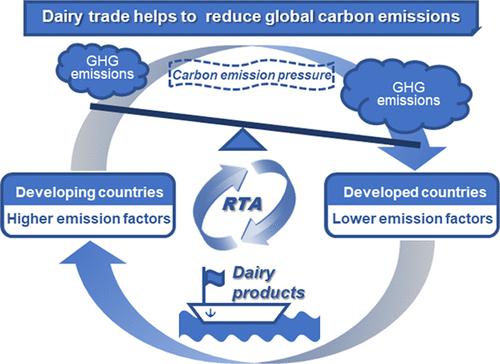当前位置:
X-MOL 学术
›
Environ. Sci. Technol.
›
论文详情
Our official English website, www.x-mol.net, welcomes your
feedback! (Note: you will need to create a separate account there.)
Dairy Trade Helps to Alleviate Global Carbon Emission Pressure
Environmental Science & Technology ( IF 10.8 ) Pub Date : 2022-08-09 , DOI: 10.1021/acs.est.2c00623 Yanjie Wu 1, 2 , Xianqiang Mao 1, 2 , Jianhong Lu 1, 2 , Mudan Wang 1, 2 , Qingyong Zhang 1, 2 , Peng Song 3 , Zhengyan Liu 4 , Wenwen Gong 5
Environmental Science & Technology ( IF 10.8 ) Pub Date : 2022-08-09 , DOI: 10.1021/acs.est.2c00623 Yanjie Wu 1, 2 , Xianqiang Mao 1, 2 , Jianhong Lu 1, 2 , Mudan Wang 1, 2 , Qingyong Zhang 1, 2 , Peng Song 3 , Zhengyan Liu 4 , Wenwen Gong 5
Affiliation

|
Global dairy production, consumption, and trade are growing rapidly, driven by population and per capita income growth and increasing health concerns mainly from developing countries, which has aroused concerns about the related carbon emission (mostly in the form of methane) increase. If all of the dairy products consumed were produced locally/domestically in the developing countries/economies (a counterfactual scenario), the carbon emissions in 2018 would be 28 Mt CO2-equiv higher than its status quo (a factual scenario). The present study indicates that unlike in many global trade cases in which carbon leakages are from developed to developing countries, global dairy trade is characterized by net embodied carbon flows from developed to developing countries/economies due to the fact that there is an overwhelming one-way-flow of dairy products from developed to developing countries/economies. The differences in the carbon emission factors between the developed and developing countries/economies provide an opportunity that global dairy trade and production specialization can help to reduce carbon emissions from increasing dairy product demand, and the total reduction potential is estimated to be about 414 Mt CO2-equiv from 2018 to 2030. Free trade agreements such as the Regional Comprehensive Economic Partnership will incentivize larger carbon emission reduction benefits through promoting dairy trade.
中文翻译:

乳制品贸易有助于缓解全球碳排放压力
在人口和人均收入增长以及主要来自发展中国家的健康问题日益增加的推动下,全球乳制品生产、消费和贸易正在迅速增长,这引起了对相关碳排放(主要以甲烷形式)增加的担忧。如果消费的所有乳制品都是在发展中国家/经济体本地/国内生产的(反事实情景),2018 年的碳排放量将为 28 Mt CO 2-equiv 高于其现状(实际情况)。本研究表明,与许多碳泄漏从发达国家流向发展中国家的全球贸易案例不同,全球乳制品贸易的特点是从发达国家流向发展中国家/经济体的净隐含碳流,因为存在压倒性的单向乳制品从发达国家流向发展中国家/经济体的途径。发达国家和发展中国家/经济体之间碳排放因子的差异为全球乳制品贸易和生产专业化有助于减少乳制品需求增加带来的碳排放提供了机会,预计总减排潜力约为 414 Mt CO 2-相当于2018年至2030年。区域全面经济伙伴关系等自由贸易协定将通过促进乳制品贸易来激励更大的碳减排收益。
更新日期:2022-08-09
中文翻译:

乳制品贸易有助于缓解全球碳排放压力
在人口和人均收入增长以及主要来自发展中国家的健康问题日益增加的推动下,全球乳制品生产、消费和贸易正在迅速增长,这引起了对相关碳排放(主要以甲烷形式)增加的担忧。如果消费的所有乳制品都是在发展中国家/经济体本地/国内生产的(反事实情景),2018 年的碳排放量将为 28 Mt CO 2-equiv 高于其现状(实际情况)。本研究表明,与许多碳泄漏从发达国家流向发展中国家的全球贸易案例不同,全球乳制品贸易的特点是从发达国家流向发展中国家/经济体的净隐含碳流,因为存在压倒性的单向乳制品从发达国家流向发展中国家/经济体的途径。发达国家和发展中国家/经济体之间碳排放因子的差异为全球乳制品贸易和生产专业化有助于减少乳制品需求增加带来的碳排放提供了机会,预计总减排潜力约为 414 Mt CO 2-相当于2018年至2030年。区域全面经济伙伴关系等自由贸易协定将通过促进乳制品贸易来激励更大的碳减排收益。











































 京公网安备 11010802027423号
京公网安备 11010802027423号